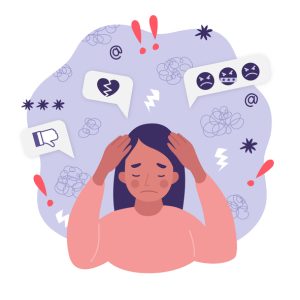|
Getting your Trinity Audio player ready...
|
A stress leave from work is a huge transition and can be a stressful, scary and uncomfortable experience. But it doesn’t have to be this way.
As a career development professional, you can help shift clients from simply taking time away from work to experiencing a successful stress leave. This two-part article aims to help guide you through this.
- Part 1: Identifying common interferences and their potential impacts.
- Part 2: How to work through these interferences.
By informing yourself of the common interferences that a client may experience during a stress leave, and their impacts, you will be better equipped to recognize challenges and help your client create a plan to work through them.
Understanding ‘success’ in stress leave The purpose of a stress leave is “to heal from the physical and emotional toll of life.” So, what makes it “successful” – or not?
While the parameters of an individual’s stress leave may be defined in co-ordination with their employer, it is up to the client to define what would make it “successful.” Part of your role may be to work with clients to help them determine what a successful stress leave is to them. To understand “success” in a more general sense, I refer to the Mental Health Continuum Model (MHCM), which categorizes mental health in four categories: healthy, reactive, injured and ill. Drawing on this model, a successful stress leave facilitates improvement of mental health, ideally moving away from “ill” and “injured” to more “healthy” and less “reactive” mental and emotional states. This does not mean the absence of stress (as we need a certain level of stress to thrive and survive) but instead means that the individual’s stress is at a manageable level where they can engage in their day-to-day activities and have a greater overall sense of well-being.
6 common interferences and their impacts on stress leave
Based on my experience working in Employee and Family Assistance Programs, I have compiled the 6 most-common interferences that get in the way of a successful stress leave.
Interference #1: No goals and action plan
A stress leave may be a first (and courageous!) step but how your client uses that time is an equally important factor in achieving a successful stress leave.
The clients I see struggling the most are the ones who don’t set up specific goals and actions steps. They plan up to the stress leave – and that’s it.
Potential impact: Having no goals or unclear goals can lead to lack of routine, structure and purpose. Clients may find themselves struggling with what to do and how to organize their day.
This leaves space for a host of secondary interferences (such as negative thoughts and anxiety) to take over, which could leave the client feeling feel worse. This might push the client to return to a work situation that was not conducive to their mental and emotional well-being. Any client who says a stress leave was not good for them likely did not have a stress-leave plan in place.
“The clients I see struggling the most are the ones who don’t set up specific goals and actions steps.”
Interference #2: Not addressing the stress/stressors
A client’s job may or may not be their only or primary source of stress. There are other life stressors – chronic or acute – that can lead to a client taking a stress leave.
Potential impact: Left unaddressed, and without a solution or plan to manage the stress, the leave itself will likely provide short-term reprieve but may fail to provide a long-term plan for improved health and well-being. This can lead to what I call the “cycle of stress leave.”
Interference #3: Cognitive distortions, self-limiting beliefs and guilt

Stress can come from external and uncontrollable factors, but it can also be a result of – and/or made worse by – our perceptions, beliefs and thinking patterns. This is why two people can experience the same thing and one person experiences stress and the other does not.
Cognitive distortions describe irrational thinking patterns that are not based in fact or reality. Examples you may be familiar with include catastrophizing – “I can’t function at work, I can’t do anything anymore” – or emotional reasoning – “I feel I am going to get fired, so I am getting fired.”
Self-limiting beliefs may include thoughts like “Stress leave is for the weak.”
Guilt deserves a place on its own. It can sound like, “I feel bad that my co-worker is now left alone to do the job” or “I can’t just leave my customers like this.”
Potential impact: These thoughts/beliefs distort the client’s perception of their situation, contributing to declining mental and emotional well-being and increased stress. They can pave the way for unhealthy decisions and undesirable outcomes.
Interference #4: Not accessing appropriate health-care resources and support
Chronic stress and burnout are serious issues, but your client may also have other mental and physical health issues that need to be treated and/or looked after.
Potential impact: By not addressing and accessing appropriate and necessary support, your client may not be getting to the root of the problem. They could find themselves in a similar or worse situation, defeating the purpose of the stress leave.
Interference #5: Weak boundaries
Although many workplaces have policies to not contact employees on stress leave (outside of necessary HR functions), this is not always the case. Clients must be proactive in setting boundaries. Examples of poor boundaries may include physical tasks (e.g. checking emails, responding to texts) and mental and emotional boundaries (worrying how the work will get done in their absence).
Potential impact: Weak boundaries do not allow the client to fully disengage from work, possibly preventing them from physically and emotionally healing.
Interference #6: Poor return-to-work planning
A client may or may not return to their place of work, but if they do, a return-to-work plan needs to be in place – regardless of the length of their leave. This can include accommodations and setting up ongoing support.
Potential impact:
If a client simply takes some time away from work and returns to the exact same situation, they may again find themselves in a stressful situation with no improvement and/or deteriorating health.
Where do we go from here?
Awareness is the starting place. I hope that by highlighting some common interferences and their negative impact on a stress leave, you are more able to recognize potential problems. Watch for part 2 of this article, where I will look at how you can support clients through these obstacles.







